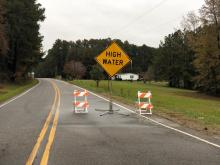- 'We gutted every building' | Chimney Rock rebuilding after Hurricane Helene
- 'We gutted every building' | Chimney Rock rebuilding after Hurricane Helene
- Debris from Hurricane Helene provides fuel, complicates containment for spring wildfires
- David & Nicole Tepper increase Hurricane Helene relief commitment to $750k
- David & Nicole Tepper increase Hurricane Helene relief commitment to $750k
Water rescues play vital life-saving role in major hurricanes

Raleigh, N.C. — “It could have been worse, but we’re thankful it wasn’t.”
From flash flooding to river flooding, a crucial part of North Carolina’s disaster response is federal and state water rescue teams and the life-saving emergency workers who assist them.
When Hurricane Floyd hit in 1999, the storm caught North Carolina unprepared for flooding, and 52 people died in the storm.
“Floyd was really eye-opening in what was missing and what needed to happen,” said Brian Barnes, who oversees water rescue teams for state Division of Emergency Management.
When Hurricane Matthew struck in 2016, federal, state and local departments stepped up with trained rescue teams who saved hundreds, although the storm still claimed 22 lives.
Close to one quarter of the people killed in this year in Hurricane Florence drowned in cars or trucks, a percentage much higher that in hurricanes Matthew and Floyd.
According to Barnes, the water rescue teams are a vital piece to North Carolina’s emergency response efforts.
When Hurricane Florence gave North Carolina a beating in September, that response played out. Officials said flood damage surpassed Floyd and Matthew combined. Forty-two people were killed, but without an even stronger emphasis on water rescue training, officials said the death toll would have climbed even higher.
“In Hurricane Florence, we conducted about three-and-a-half times the rescues and contacts that we did with Hurricane Matthew,” said Barnes.
Federal and state water rescue teams accounted for more than 5,200 rescues and evacuations – and that figure doesn’t include local teams.
With Florence a nightmare past, Capt. Mike Davidson of the Raleigh Fire Department is already planning for the future.
“We were very prepared and anticipating the worst for Florence,” said Davidson. “The next storm could be a major named storm. We get these summer downbursts.”
When Davidson joined the Raleigh Fire Department 27 years ago, the department had two flat-bottom boats used mostly to recover bodies. A lot has changed since then.
Raleigh now has more than 60 firefighters trained and certified in water and other specialized rescues.
The department shares a fleet of specially designed boats with teams in Chapel Hill and Durham, and responders are outfitted in rescue gear to better protect them and the people they save.
Still, Davidson said he would like to see more state and federal funding to back the mission.
“I would say our biggest need is more training,” he said. “It could have been worse, but we’re thankful it wasn’t, and we’re thankful for the resources that were in place in our time of need.”
The state legislature recently approved a $2.3 million appropriation for search and rescue programs. $1.9 million of that has been spent to order more than 45 rescue boats and motors as well as personal protective gear to help build water rescue capability. The equipment will go to swift water rescue teams around the state to replace boats that are worn out and to add new boats.
Water rescue is not typically an eligible item for federal grants, so state funding was necessary. The equipment has been ordered and delivery is expected in a few months.
Barnes said that, in addition to all the training and resources, the public still plays the biggest role in saving lives for the next storm.
“If folks are going out and driving and taking unnecessary risks, then no resource is going to be close enough,” he said.
